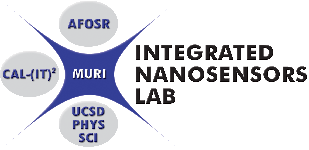Research

Chemical sensing using metallophthalocyanines
Objective
Develop selective chemical sensors with fast response times:
• Create amorphous thin films using substituted metallophthalocyanines (MPc).
•Study thin films by:
› Atomic Force Microscopy.
› Electron Paramagnetic Resonance.
› Scanning Tunneling Microscopy.
•Gain selectivity by varying metal and substituent.
•Nanolithography to fabricate nanogap electrodes.
•Create working devices with micro- or nanogaps between electrodes coated with MPc.
•Develop method to characterize and test device.
•Test for selectivity and sensitivity.
•Improve response times.
 |
 |
Fig.
1 AFM of Cu-tBuPc. |
Fig.
2 XRD of Cu-tBuPc. |
 |
|
Fig.
3 Thin film sensor. |
|
Results
•Films become amorphous as substituent increases.
•Several materials for use as films synthesized.
•Microlithography and sensor tested.

